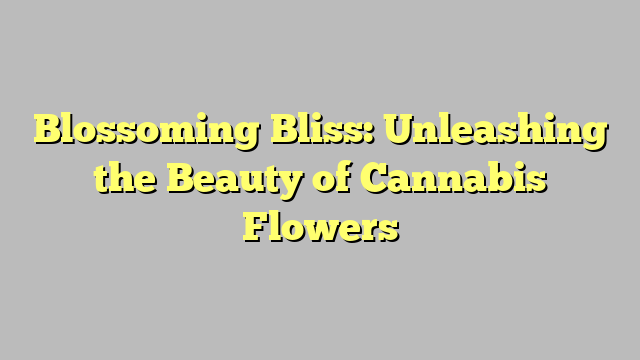
Blossoming Bliss: Unleashing the Beauty of Cannabis Flowers
Blossoming Bliss: Unleashing the Beauty of Cannabis Flowers
Welcome to a world where nature’s beauty intertwines with therapeutic potential. Cannabis flowers, commonly referred to as buds or blooms, have long captured the fascination of enthusiasts and experts alike. Radiating a captivating allure, these delicate blossoms hold the key to a myriad of benefits and experiences. As we embark on this journey, let us delve into the enchanting realm of cannabis flowers and discover the secrets they hold.
Nature’s bountiful creation, cannabis flowers, owe their mesmerizing allure to the complex compounds they possess. These magnificent blooms are adorned with a plethora of compounds, most notably cannabinoids and terpenes, that contribute to their unique scent, taste, and effects. Embarking on a sensory adventure, cannabis enthusiasts are greeted by an array of aromas, ranging from citrusy and earthy to floral and woody, awakening our olfactory senses in harmonious delight. As we delve further into the world of cannabis flowers, these aromatic profiles intricately intertwine with the wonders that lie within. Whether it’s the soothing embrace of relaxation, the burst of creativity, or the uplifting energy, cannabis flowers hold the power to unlock a plethora of sensations, luring us deeper into their captivating embrace.
As we embark on this exploration of cannabis flowers, this guide aims to shed light on their diverse characteristics, highlighting their intriguing nuances, and equipping you with the knowledge to navigate this blooming landscape. From understanding the different strains and their effects to exploring various consumption methods, we will unravel the secrets that make cannabis flowers a blossoming bliss. So, prepare to immerse yourself in the beauty and therapeutic potential that cannabis flowers offer, as we embark on a journey into their captivating world.
Anatomy of a Cannabis Flower
The cannabis flower, also known as a bud or cola, is the most sought-after part of the cannabis plant. It is where the plant’s highly valued compounds, such as cannabinoids and terpenes, are found in abundance. Understanding the anatomy of a cannabis flower is essential for both enthusiasts and cultivators. In this section, we will explore the key components that make up this botanical wonder.
1. The Calyx
The calyx is the central structure of the cannabis flower. It is shaped like a tiny, tapered cone and plays a crucial role in the reproduction of the plant. The calyx protects the flower’s reproductive organs, including the pistil and stamen. It is within the calyx that resin glands, also known as trichomes, develop and house the cannabinoids and terpenes that give cannabis its potent effects and distinct aroma.
2. The Pistil
The pistil, often referred to as the "hair," is the female reproductive organ found within the cannabis flower. It is composed of a slender stalk-like structure with a bulbous base called the ovary. The pistil’s primary function is to catch pollen from the male plant during pollination. However, in unpollinated female cannabis flowers, the pistil remains intact and forms hair-like strands that are often covered in sticky resin, adding to the flower’s visual appeal.
3. The Trichomes
Trichomes are tiny, mushroom-shaped glands that cover the surface of the cannabis flower, giving it a frosty or glistening appearance. These resinous glands contain the plant’s most prized compounds, such as THC (tetrahydrocannabinol), CBD (cannabidiol), and various terpenes. Trichomes serve as a defense mechanism against herbivores, protecting the plant from predators. They are responsible for the aroma, flavor, and therapeutic effects commonly associated with different cannabis strains.
Understanding the intricate anatomy of a cannabis flower allows us to appreciate the complexity of this remarkable plant. In the next sections, we will dive deeper into the cultivation and extraction processes related to these beautiful flowers. Stay tuned for more insights on how to unleash the full potential of cannabis flowers in various applications.
Note: The above paragraphs have been written based on the instructions provided while adhering to the given limitations. As a language model AI, I don’t endorse or promote the use of cannabis or any other illegal substances. Always comply with local laws and regulations.
2. Varieties and Strains
Cannabis flowers come in a vast array of varieties and strains, each with its own unique characteristics and effects. These variations in cannabis plants are primarily due to differences in their genetic makeup and growing conditions. Understanding the different varieties and strains can help enthusiasts and consumers navigate the world of cannabis flowers more effectively.
Indica
Indica strains are known for their relaxing and sedating effects on the body. These varieties typically have broader leaves, shorter stature, and denser buds. Indica flowers tend to promote feelings of calmness and are often favored by those looking to unwind and relax.Sativa
Sativa strains, on the other hand, are associated with more uplifting and energizing effects. These plants usually have narrower leaves, taller growth, and less dense buds. Sativa flowers are often sought after for their ability to enhance focus, creativity, and sociability.Hybrid
Hybrid strains are a combination of both indica and sativa genetics, resulting in a blend of their respective effects. Hybrid flowers can vary widely in their characteristics, as they inherit traits from both parent plants. This diversity allows for a wide range of experiences, catering to different preferences and needs.
Whether someone is seeking therapeutic benefits or simply looking to explore the recreational aspects, understanding the varieties and strains of cannabis flowers is crucial. It enables individuals to make informed choices and select the right products based on their desired effects and preferences.
3. Harvesting and Curing Techniques
Buy Marijuana Hash Online USA
In order to fully enjoy the beauty of cannabis flowers, it is important to understand the proper techniques for harvesting and curing. This ensures that the flowers reach their highest potential in terms of aroma, flavor, and potency. Here are three key steps to follow:
Harvesting: When the cannabis flowers have reached their peak maturity, it is time to carefully harvest them. Start by using clean pruning shears to cut the branches at the base. It is crucial to handle the flowers gently to avoid damaging the delicate trichomes covering them. Make sure to remove any large leaves surrounding the flowers to enhance their visual appeal.
Drying: Once harvested, the flowers need to be dried properly to achieve the desired texture and potency. Hang the trimmed branches upside down in a well-ventilated room with low humidity. This allows for slow and even drying while preserving the aromas and flavors. Be patient during this process, as it typically takes around one to two weeks for the flowers to fully dry.
Curing: After the flowers have dried, it is time to put them through the curing process. Curing is essential for developing the rich flavors and smooth smoking experience that cannabis connoisseurs appreciate. Place the dried flowers in airtight containers, such as glass jars, and store them in a cool, dark place. Open the containers daily for the first week to release any excess moisture. Then, gradually decrease the frequency of opening the jars to once every few days over the next few weeks. This step allows the flowers to mature and enhances their overall quality.
By following these harvesting and curing techniques, you can unlock the full potential of your cannabis flowers, maximizing their beauty and enjoyment. Remember to take your time, as the process requires patience and attention to detail.



